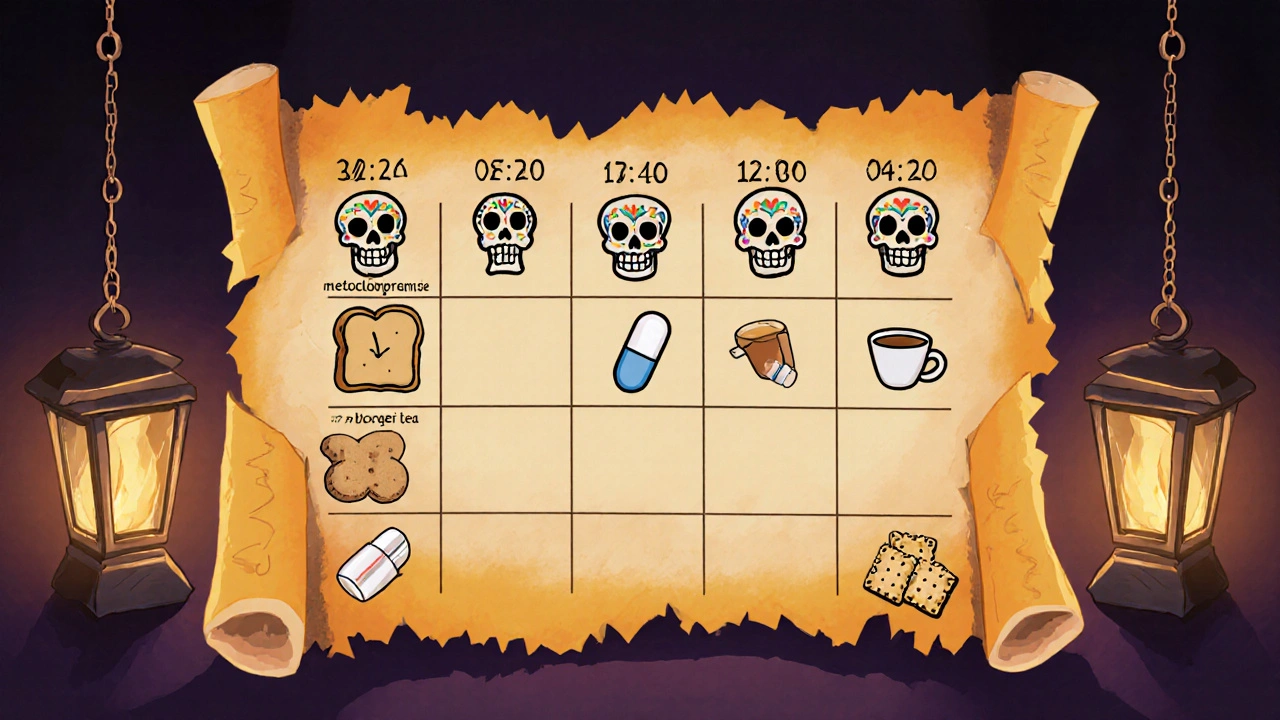Managing Opioid‑Induced Nausea: Antiemetics, Timing Tips & Diet Hacks
 Oct, 24 2025
Oct, 24 2025
Opioid Nausea Management Calculator
Enter your opioid dose and schedule to calculate the best time to take antiemetics for maximum effectiveness.
Recommended antiemetic timing:
30-60 minutes BEFORE opioid dose
Important: For best results, take antiemetic 30-60 minutes BEFORE your opioid dose. If your dose is at 8:00 AM, take antiemetic between 7:00-7:30 AM.
This aligns with the article's recommendation to match peak antiemetic effect with opioid absorption.
Sample Daily Schedule
7:00 AM - Antiemetic (30-60 min before opioid)
7:30 AM - Opioid dose
8:00 AM - Small, bland meal (e.g., toast)
11:30 AM - Antiemetic
12:00 PM - Opioid dose
12:30 PM - Light snack (e.g., rice crackers)
When opioid‑induced nausea and vomiting a common side effect that can derail pain control shows up, it feels like the medication meant to help is suddenly working against you. Roughly one‑third of people starting opioids will wrestle with nausea in the first few days, and that can make sticking to a pain regimen almost impossible. The good news? A mix of the right antiemetic, smart timing, and a few diet tweaks can shrink the problem dramatically.
Key Takeaways
- Start opioids at 25‑50 % of the usual dose and increase slowly to cut nausea risk by ~35 %.
- Give antiemetics 30‑60 minutes before opioid doses for peak effect.
- First‑line antiemetic for most patients: metoclopramide 5‑10 mg every 6‑8 hours.
- Consider opioid rotation (e.g., morphine ➜ oxycodone) if nausea persists despite medication.
- Small, frequent meals and avoiding high‑fat foods help keep the stomach settled.
Why Opioids Trigger Nausea
The brain’s chemoreceptor trigger zone (CTZ) houses mu‑opioid receptors. When opioids bind there, they fire a cascade that sends a nausea signal to the vomiting center. The effect peaks about an hour after oral dosing, which is why timing matters. Some patients also develop delayed gastric emptying, making the stomach feel full and queasy.
Choosing the Right Antiemetic
Antiemetics fall into a few classes, each hitting a different part of the nausea pathway. Below is a quick look at the most commonly used drugs.
| Drug | Typical Dose | Primary Action | Key Side Effects |
|---|---|---|---|
| Metoclopramide | 5‑10 mg PO q6‑8 h | Prokinetic + D2 blockade | Extrapyramidal symptoms (10‑15 % at high doses) |
| Haloperidol | 0.5‑1 mg PO q12 h | D2 antagonist | Parkinsonism risk in >65 yr (20‑25 %) |
| Ondansetron | 4‑8 mg PO/IV q8 h | 5‑HT3 antagonist | Constipation, headache |
| Prochlorperazine | 5‑10 mg PO q6‑8 h | Phenothiazine D2 blocker | Drowsiness, low‑BP |
| Dexamethasone | 4‑8 mg IV q24 h | Corticosteroid anti‑emetic | Hyperglycemia, insomnia |
For most opioid‑naïve patients, metoclopramide is the go‑to choice because it also speeds up stomach emptying. If a patient has a history of Parkinson’s or is over 65, you might skip haloperidol and head straight to ondansetron or a phenothiazine.
Timing Your Medications
Peak opioid concentrations appear 60‑90 minutes after oral intake. To line up the antiemetic’s peak effect, give it 30‑60 minutes before the opioid. For IV opioids, a 15‑minute lead‑in works well. If you’re on a schedule of every 4‑6 hours, keep the antiemetic on the same clock so you never miss the window.

Start Low, Go Slow - The Proven Dosing Strategy
Dr. Eduardo Bruera’s “start low, go slow” protocol suggests beginning with 25‑50 % of the usual opioid dose (e.g., morphine 2.5‑5 mg PO q4 h) and titrating up by 25‑50 % every 24‑48 hours. Studies show this cuts early‑onset nausea by about 35‑40 % because the body has time to adapt.
When Antiemetics Aren’t Enough: Opioid Rotation
If nausea sticks around after 3‑5 days, think about swapping the opioid. The European Association for Palliative Care notes modest success when moving from morphine to oxycodone or from tramadol to hydrocodone. A stronger option is a three‑day switch to methadone, but that needs a clinician comfortable with conversions.
Diet Tweaks That Really Help
Food doesn’t cause opioid nausea, but what you eat can calm the stomach.
- Small, frequent meals - 5‑6 mini‑meals a day keep the gut from getting too full.
- Low‑fat, bland foods - Think toast, crackers, applesauce, and plain rice.
- Stay hydrated - Sip water or electrolyte drinks throughout the day.
- Avoid strong smells - Cooking aromas can trigger the CTZ.
- Ginger - A small cup of ginger tea or candied ginger has mild pro‑kinetic effects.
Pairing metoclopramide with meals works especially well because the drug improves gastric motility, making food move faster and reducing the “full” feeling that fuels nausea.

Putting It All Together - A Sample Day Plan
Here’s a practical schedule for a patient starting oral morphine:
- 07:00 - Take metoclopramide 5 mg (30 min before opioid).
- 07:30 - Morphine 2.5 mg PO.
- 08:00 - Small breakfast: plain toast + a splash of apple juice.
- 11:30 - Metoclopramide repeat.
- 12:00 - Morphine 2.5 mg PO.
- 12:30 - Light snack: rice crackers + ginger tea.
- 15:30 - Metoclopramide repeat.
- 16:00 - Morphine 2.5 mg PO.
- Evening - Continue the pattern, add a small dinner of boiled chicken and steamed carrots.
Adjust doses upward by 25 % every two days if pain control is still inadequate and nausea stays mild.
Common Pitfalls and How to Avoid Them
- Skipping the antiemetic timing - Giving it after the opioid blunts its effect.
- Over‑relying on one drug - Rotate or combine antiemetics if nausea persists.
- Ignoring side‑effects - Watch older adults for haloperidol‑induced Parkinsonism.
- Not adjusting the opioid dose - A 25‑30 % dose reduction can sometimes clear nausea without harming analgesia.
When to Call Your Healthcare Provider
If you experience any of the following, seek help right away:
- Severe vomiting that leads to dehydration.
- Extrapyramidal symptoms such as muscle stiffness or tremor.
- Persistent nausea after a week of combined antiemetic therapy.
- New onset of chest pain or shortness of breath (could signal opioid toxicity).
Bottom Line
Managing opioid‑induced nausea isn’t a one‑size‑fits‑all job. By starting low, timing antiemetics ahead of opioids, choosing the right drug class, and adding simple diet tricks, most patients can stay on their pain meds without the queasy side‑effects. Keep a short log of doses, antiemetic timing, and meals - that log becomes the fastest way to spot patterns and tweak the plan.
What is the best first‑line antiemetic for opioid nausea?
For most opioid‑naïve patients, metoclopramide 5‑10 mg taken every 6‑8 hours is the preferred option because it also speeds up stomach emptying.
How long does it take for the body to get used to opioid‑induced nausea?
Tolerance usually develops after 3‑7 days of a stable opioid dose, but the first 24‑48 hours are the most vulnerable.
Can changing the timing of my opioid dose help?
Yes. Taking the opioid with a small snack and giving the antiemetic 30‑60 minutes before the opioid can align peak drug levels and cut nausea.
When should I consider opioid rotation?
If nausea persists beyond 5 days despite a suitable antiemetic, or if you need increasingly higher opioid doses, discuss rotating to another opioid such as oxycodone or hydromorphone.
Are there any foods that make opioid nausea worse?
High‑fat, greasy, or heavily spiced meals can slow gastric emptying and trigger the CTZ. Stick to low‑fat, bland options and avoid strong cooking smells.
krishna chegireddy
October 24, 2025 AT 19:23What they don’t tell you is that the nausea trigger is baked into the opioid formula to keep patients hooked, so the “timing tips” are just a Band‑Aid over a deeper control scheme.
Tamara Schäfer
November 1, 2025 AT 16:23Imagine a world where we could retrain our gut to ignore the chemical alarm, letting the pain med do its job while the stomach stays calm – it’s more than a dream, it’s literally possible if we follow the simple steps listed here, definately worth a try.
Brett Witcher
November 9, 2025 AT 14:23The pharmacokinetic window described aligns antiemetic peak concentration with opioid absorption, which scientifically reduces the incidence of emesis by approximately one‑third when adhered to consistently.
Benjamin Sequeira benavente
November 17, 2025 AT 12:23Kick that nausea to the curb by loading metoclopramide 30 minutes before your dose, keep meals tiny and bland, and remember: if it still spins, rotate the opioid – no excuses, just action.
Shannon Stoneburgh
November 25, 2025 AT 10:23Most patients ignore the simplest tip – eat a cracker before the dose – and then blame the doctor for “bad meds”.
Olivia Harrison
December 3, 2025 AT 08:23Hey there, I’ve been helping folks manage opioid side‑effects for years and I can tell you the plan you just read works like a charm when you stick to it. First, always log the exact time you take your opioid and the antiemetic; the data will quickly show you where the gaps are. Second, keep your meals mini – think a slice of toast or a few rice crackers – because a big heavy plate will only push the stomach into a “full” state that triggers the CTZ. Third, ginger isn’t just a kitchen spice; a warm cup of ginger tea can gently stimulate gastric motility and calm the nausea loop. Fourth, if you notice drowsiness from metoclopramide, you can alternate with ondansetron every other dose to spread out side‑effects. Fifth, stay hydrated – sip water all day, but avoid gulping large amounts right before the opioid. Sixth, watch for any extrapyramidal signs like twitching; if they appear, taper the metoclopramide and discuss alternatives with your provider. Seventh, give the antiemetic a half‑hour before the opioid; the timing is the cheap hack that makes a big difference. Eighth, if after a week the nausea lingers, bring up opioid rotation – sometimes a switch to oxycodone or hydromorphone resolves the issue without changing the dose. Ninth, involve a caregiver or family member in your schedule so you don’t miss a dose and the whole routine stays smooth. Tenth, remember that stress can amplify nausea, so incorporate brief breathing exercises before each dose. Eleventh, keep your sleep hygiene steady; irregular sleep can upset gastrointestinal rhythms. Twelfth, be patient – your body typically adapts within three to seven days, but the first 48 hours are the toughest. Thirteenth, if vomiting becomes severe, seek medical help promptly to prevent dehydration. Fourteenth, always discuss any new symptoms like chest pain with your clinician right away. Finally, stay positive and trust that with these small adjustments you’ll keep the pain under control without the queasy side‑effects.
ram kumar
December 11, 2025 AT 06:23Sure, blame the pharma cartel all you want, but the data in the article proves that simple timing and diet actually cut nausea, so maybe the “hidden agenda” is just good science.
Charlie Stillwell
December 19, 2025 AT 04:23While the pharmacokinetic alignment is theoretically sound, the real‑world implementation often suffers from “patient non‑adherence entropy” 🤷♂️ – a classic case of ideal vs. pragmatic pharmacodynamics. 📊